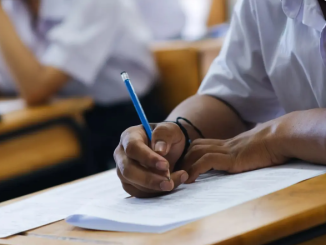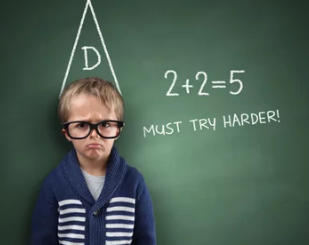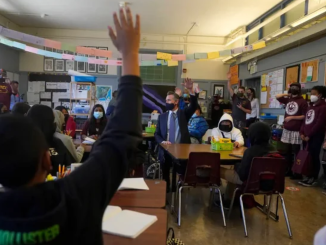
New York City public schools have failed kids on multiple fronts – and as soon as they leave the system, the catastrophic toll of years of mis-education becomes glaringly apparent.
Amid chronic absenteeism, widespread grade inflation, and a failure to prepare students for introductory college classes, city school kids are being shoved through an educational revolving door without truly learning, experts told The Post.
“Most of the kids we get from New York City schools are underprepared for college,” said Mohammad Alam, assistant dean of enrollment at Borough of Manhattan Community College.
In Fall 2022 across the City University of New York’s seven community colleges, 5,046 former Department of Education students were enrolled in a remedial math course, while 4,250 had to take remedial English — 47% of all new DOE high school graduates, a CUNY spokesperson said.
The lack of readiness for college work leaves students, some now parents themselves, frustrated — and angry.
Sáleenal Butler says her public NYC high school failed to prepare her for college-level math.
Helayne Seidman
“I don’t think high schools, especially public schools in The Bronx, prepared me enough” for college, said Priscilla Walker, a Bronx mom of two who at 29 is still struggling to earn an associate’s degree from BMCC. “That’s how the public school system runs: ‘These are not my kids, I just don’t care.’”
Sáleenal Butler, 20, complained that teachers at her former high school, Millennium Art Academy in the Bronx, “got annoyed when people asked questions” – which was why she had to start her Bronx Community College career in a remedial math class.
“Most are just overwhelmed by how many students they have,” Butler said.
Julian Espinosa was “barely given the tools to succeed” at his Manhattan high school.
Helayne Seidman
Julian Espinosa, 24, said he was “barely given the tools to succeed” at Manhattan’s A. Philip Randolph High School. The Bronx resident had to take remedial math when he first enrolled at BCC in 2016 – an experience so discouraging, he promptly dropped out.
“I don’t remember anything [I learned] from high school,” admitted Elian Luna, 21, who graduated from Bronx Academy of Software Engineering in 2019 and liked his teachers but had to take remedial math at BCC.
The cracks in the system show up long before students hit high school.
Post-pandemic test scores are down in K-8 public schools across the city, while chronic absenteeism last year hit an all-time high of 40%. That means 352,919 kids missed 18 or more days of instruction, or 10% of the entire year. Among seniors at Bronx high schools, chronic absenteeism hit a shocking 58.2%, according to the DOE.
Elian Luna, seen here at his 2019 high school graduation, now says he doesn’t remember anything he learned there — and had to re-take math at Bronx Community College.
Elian Luna
Yet, magically, graduation rates for high school inched up again last year, to nearly 84% compared to 73% four years earlier, with lower standards paving the way.
“Dumb it down until everybody passes,” said Wai Wah Chin, founder of the Chinese American Citizens Alliance of Greater New York and a school-choice booster.
Lowing the bar in the name of “equity” — just to get students through the system — harms grads as well as society, Chin argued.
Former mayors demanded yearly jumps in the graduation rate to boost their own political ambitions. As a result, DOE grade inflation – and even fraud – has surged.
In 2015, Brooklyn’s Dewey High School put hundreds of failing kids in phantom classes without certified teachers. Principal Kathleen Elvin called the scheme “Project Graduation.” Kids dubbed it “Easy Pass.”
At Maspeth HS, under ex-principal Khurshid Abdul-Mutakabbir, the school created fake classes, gave credits to failing students, and fixed grades to push kids out the door, outraged teachers told The Post in 2019. Students called the no-fail policy the “Maspeth minimum.” Abdul-Mutakabbir reportedly said he would give a straggling student a diploma “not worth the paper on which it was printed.”
Last year, teachers at William Cullen Bryant HS in Queens charged administrators pressured them to promote students who skipped classes – or never came at all – and did little or no work. In the DOE, kids can pass or graduate without going to class.
At the same time, the DOE bureaucracy ballooned. Managers, analysts, supervisors and specialists — educrats who don’t step foot in classrooms — rose to 5,100 from 3,500 between 2014 and 2021, the Independent Budget Office tallied.
Chancellor David Banks vowed to cut the bloat, but in his first six months DOE central and district offices racked up $725 million in expenses for FY 2022, more than $100 million over budget, the IBO found, even as school budgets were cut.
Borough of Manhattan Community College, one of CUNY’s two-year colleges, provides remedial “corequisite” courses for students who can’t handle college-level work.
Erik McGregor
The coronavirus pandemic provided fresh reasons to kick graduation standards to the curb. State Regents tests were canceled altogether in 2020 – and when they returned, new rules allowed kids to “pass” them with a 50% grade.
That steep academic decline causes catastrophe in college.
A 2022 audit of students sampled by state Comptroller Thomas DiNapoli found only 57% of DOE grads “college ready” – and of those who went on to higher ed, a staggering 37% dropped out in the first semester.
Many DOE graduates flunk CUNY’s admissions exams in English, math, or both, forcing them into remedial classes in community colleges to learn material they should have mastered years before. Those who fail the exams are barred from entering CUNY’s four-year colleges.
“The kids who come out of high school unprepared end up in the community colleges,” said the Manhattan Institute’s education maven Ray Domanico. “And those two-year colleges have awful graduation rates – like in the 20s. A lot of those kids don’t make it past that first year.”
At BCC, more than 50% of new high-school graduates who enroll can’t handle college-level work, one admissions officer there told The Post.
In a move to boost those abysmal numbers and keep students enrolled, CUNY now puts students who need remedial help in credit-bearing “corequisite” courses to make the system “more equitable,” officials say.
While enrollment in DOE schools has plummeted – 121,000 students have left since 2017 — charter schools promise a superior education for kids lagging behind in reading and math in DOE-run schools, advocates said.
“DOE schools have shown their ability to promote students through the grade levels, or graduate from the system entirely, regardless of proficiency on state assessments and classwork or even meaningful attendance in school,” said Emily D’Vertola of the Empire Center for Public Policy.
“Public charter schools, on the other hand, are held to legal standards of operation, reporting and student achievement, as laid out in charter law,” she said. “If they do not ‘pass,’ they will be shut down.” At least 20 New York “zombie charters” have lost their licenses, which advocates want to give other schools.
Charters, publicly funded but privately run, offer options that mirror higher-performing DOE schools.
A new world opened for Shontai Gillard, 17, a junior at Brooklyn Lab Charter Academy, when she transferred from the DOE’s It takes a Village Academy for 10th grade. “Now I have rigorous courses, I get a lot of AP classes,” she said. Her new teachers “are supportive, and they always push us.”
“There’s more discipline, more order” at Brooklyn Lab, said classmate Jamiyah Snipes, 16, a fellow public-school refugee.
Cynthia Estevez, a graduate of Brooklyn’s MESA Charter High School, says daily meetings with her adviser helped her stay on track.
Stephen Yang
Charters also demand accountability, students say. At Brooklyn’s MESA Charter High School, for example, each teen meets with their faculty adviser twice a day, reviewing weekly reports from every class and escalating absences – including cut classes – to parents.
“That was really important for me, to kind of keep me in check,” said Cynthia Estevez, a MESA 2020 grad. “I still talk to my adviser to this day.”
Chin agreed — accountability is key to success.
“What the charters are doing is that once the kids get in, kids are held to higher standards,” she said. “It’s not that if a kid is not performing, you lower the standards to meet the kids. You raise the kid to meet the standard.”
A Decade of Dumbing-Down
From 2012 to 2022, the graduation rate in NYC’s public high schools leaped – even as chronic absenteeism rose and standards declined amid the coronavirus pandemic.
Meanwhile, the city’s per-student spending nearly doubled:
2012: $18,620
2022: $35,941
* Article from: The New York Post


